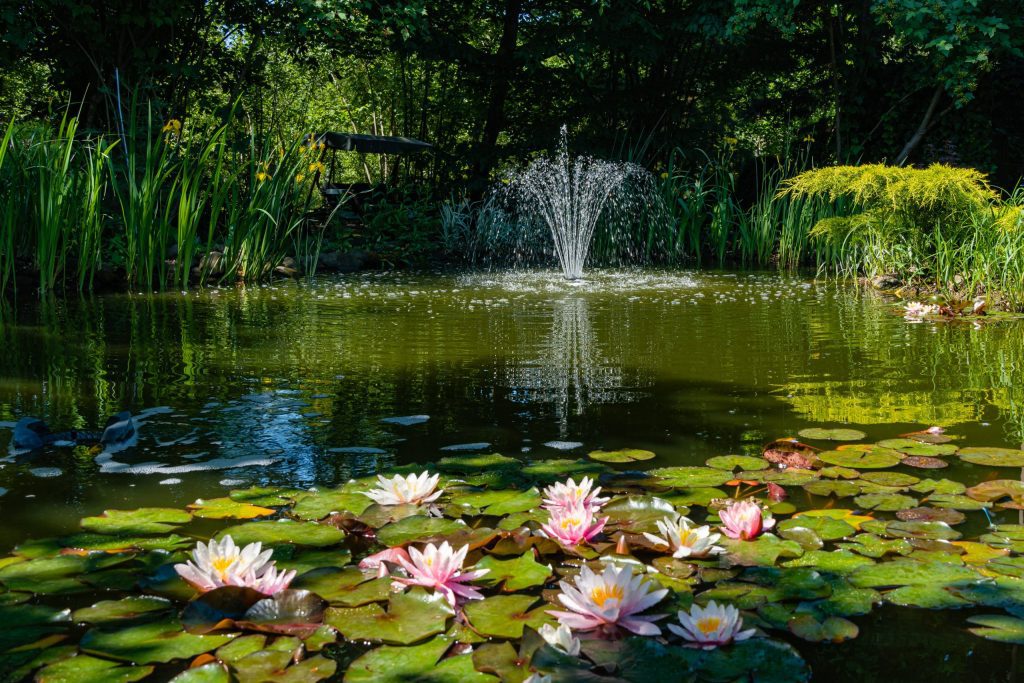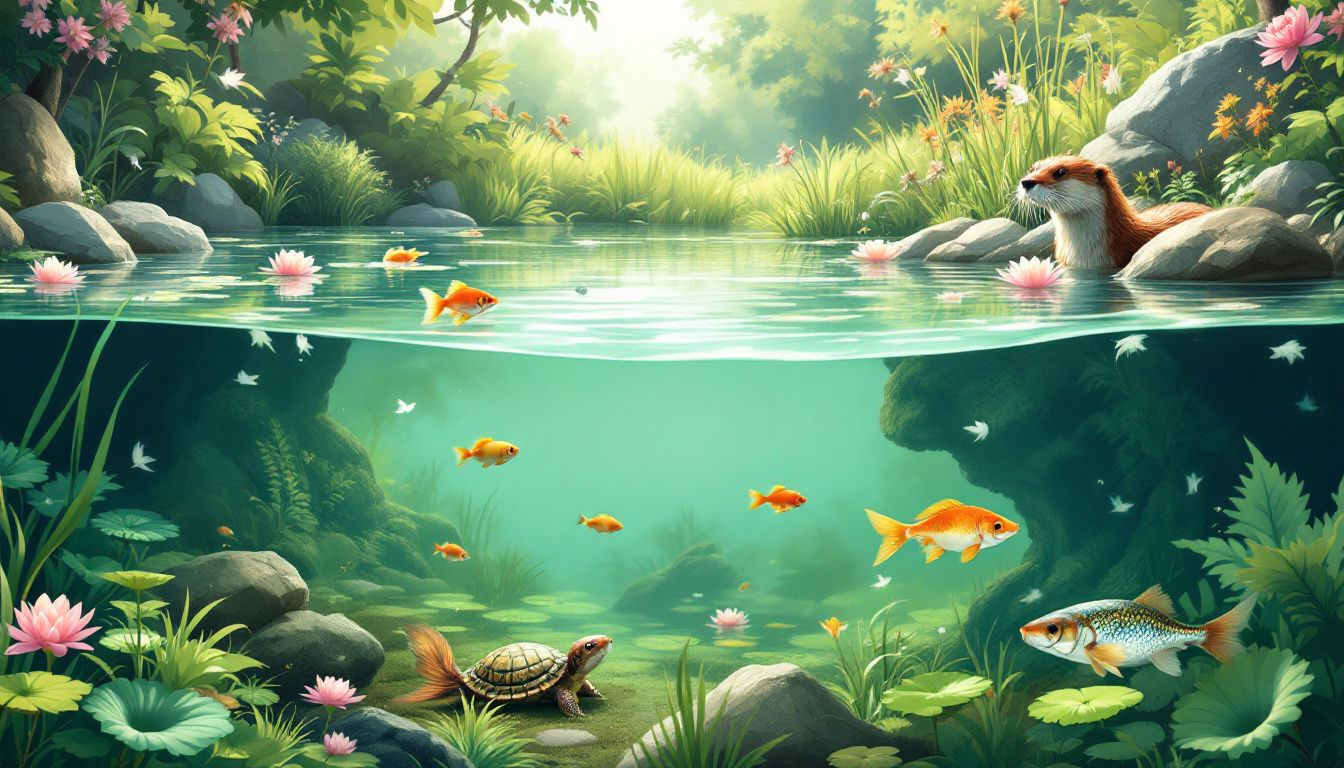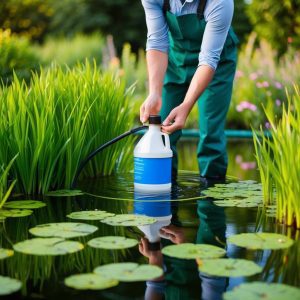
How Deep Should a Pond Be? Best Guidance for Perfect Pond Depth
When building a pond, the depth is crucial. So how deep should a pond be? The answer depends on the type of pond you have in mind. This article covers recommended depths for garden ponds, koi ponds, and wildlife ponds. Additionally, we’ll highlight how the right depth supports a healthy aquatic ecosystem.
Key Takeaways
An adequate pond depth of at least 46 cm (18 inches) is critical for stabilizing the environment and supporting aquatic life health.
Different pond types require specific depths; for example, wildlife ponds should be 25-30 cm deep, while koi ponds necessitate depths between 90 to 122 cm.
Maintaining water quality and regular monitoring are essential for a healthy pond ecosystem, including proper plant selection and seasonal maintenance.
Understanding Pond Depth Importance

The primary purpose of a garden pond extends beyond mere aesthetics; it serves as a habitat for freshwater wildlife and provides enjoyment for its caretakers. An adequate pond depth balances the ecosystem and supports both plant and wildlife health. For instance, a garden pond depth of at least 46 cm (18 inches) helps stabilize the environment by preventing temperature extremes, which can be detrimental to aquatic life.
A balanced pond depth fosters a robust ecosystem, supports beneficial plant growth, provides safe havens for fish, and keeps the water clear and healthy. This foundational understanding sets the stage for exploring the specific depth requirements for different types of ponds.
Optimal Depth for Different Pond Types
Different types of ponds require different depths to thrive. Wildlife ponds benefit from a maximum depth of 25-30 cm (1 foot) for optimal oxygenation and light penetration. Deeper sections of at least 60 cm provide a stable environment for aquatic life.
Koi ponds in the UK should ideally be 90 to 122 cm (3 to 4 feet) deep to protect against temperature fluctuations and ensure koi health. Fish ponds generally require a minimum depth of 45 cm (18 inches) to sustain fish species, with 50-60 cm being more ideal for adequate living space.
Ponds with at least 40% of their area as the deepest part, including a deep pond, help maintain stable water temperatures, crucial for aquatic well-being and pond life. Additionally, deep ponds play a significant role in this ecosystem.
Seasonal Impact on Pond Depth
Seasonal changes can significantly impact pond depth and overall health. For instance, water temperatures above 75°F can hinder oxygen retention in the pond, which is vital for the survival of fish and other aquatic organisms. Monitoring water temperature becomes especially important during hot summer months.
Winter poses its own challenges. Shallow ponds may freeze completely, which can be detrimental to fish and plants. In contrast, deeper ponds provide a refuge where water temperatures remain more stable, helping to protect aquatic life during cold weather.
Seasonal variability highlights the need to consider depth in pond design.
Designing Your Garden Pond

Designing a garden pond involves more than just digging a hole and filling it with water. A well-designed pond can enhance the overall beauty of your garden while supporting a diverse ecosystem. Incorporating plants into your pond design not only adds visual appeal but also provides habitats for wildlife and helps maintain water clarity.
Plants improve water quality by absorbing nutrients and providing oxygen. A garden pond that integrates garden ponds and floating plants along with pond plants effectively will yield a healthier and more visually appealing environment for both wildlife gardening and people.
Let’s explore the benefits of creating depth variations and choosing suitable plants for your pond.
Creating Depth Variations
A well-structured garden pond should include varying depths to create diverse habitats and stabilize water temperatures. Multiple depths create essential habitats for both fish and plants. Incorporating sloping sides in a wildlife pond allows easier access for animals and creates damp habitats as water levels change.
Shallow areas allow sunlight penetration, promoting plant growth and enhancing water quality and biodiversity. These variations not only support a wide range of species but also improve the overall resilience of the pond’s ecosystem.
Choosing Suitable Plants
Selecting the right plants for your pond is crucial. Matching aquatic plants to the specific depth of your pond ensures their health and growth. Aquatic plants thrive best when planted at their preferred water depths, which significantly impacts their growth and health.
For example, water lilies may grow too large for the average back garden pond if planted too shallow. Marginal plants, which typically thrive at depths between 6 and 12 inches, are excellent choices for the edges of the pond. Carefully selecting plants based on their depth needs creates a vibrant, healthy pond that supports diverse species.
Wildlife Pond Considerations

Wildlife ponds require special considerations to ensure they support a diverse range of species. A pond with varying depths can attract a wider range of wildlife and plant species. Correct depth supports seasonal variability and the needs of different species.
Essential components needed to design a wildlife pond include shelter, food sources, and breeding grounds. Professional designers consider factors like garden size, existing flora and fauna, sunlight exposure, and weather patterns to create suitable pond designs.
This section will delve into the importance of shallow and deep areas for pond wildlife.
Shallow Areas for Wildlife
Shallow areas, just a few inches deep, are crucial for supporting a wide range of wildlife in lakes and a small pond. Amphibians and birds rely on these shallow areas for breeding, bathing, and drinking. Incorporating a shallow slope on at least one side of the pond helps wildlife access the water and provides habitat for smaller creatures.
A range of depths allows different species to thrive, supporting overall pond health. Covering 40 to 60 percent of the pond’s surface with plants aids in filtering excess nutrients and preventing algae growth, supporting a healthy ecosystem.
Deep Areas for Habitat Stability
Deeper areas in ponds are crucial for the survival and health of pond inhabitants. These sections provide safe havens for fish and amphibians, making it harder for predators to reach them. A depth range of 20 to 60 cm is ideal for wildlife ponds to accommodate a variety of flora and fauna, maintaining stable conditions.
Regular cleaning, especially in spring, helps remove decaying debris and waste that can harm water quality. Maintaining appropriate filter systems ensures the pond’s ecosystem remains balanced and healthy.
Maintaining Water Quality

Water quality is paramount for a healthy pond ecosystem. Covering about half of the pond’s surface with foliage reduces sunlight penetration and controls algae growth. A pump that circulates the pond’s water volume at least once an hour maintains clean water.
Engaging professionals can guarantee that your pond’s ecosystem is balanced, preventing issues like algae overgrowth. Professional pond services offer tailored solutions that enhance both the visual and ecological aspects of your pond.
Water Source and Treatment
Proper water sources and treatment methods prevent the introduction of harmful invasive species into the pond. Water treatment should include safety measures to protect the pond ecosystem. Tap water should be treated to remove chlorine and other chemicals that can harm aquatic life.
Regular testing and adjusting of water chemistry support a healthy environment for plants and animals. This ensures that the pond remains a thriving habitat for all its inhabitants.
Regular Monitoring and Maintenance
Consistent water testing tracks key parameters like pH, ammonia, nitrite, and nitrate, crucial for a healthy pond environment. Test strips or electronic meters simplify the monitoring of water quality elements such as dissolved oxygen and nitrogen levels.
Monitoring dissolved oxygen, especially overnight, ensures fish survival and overall aquatic health. Keeping records of water test results helps in identifying trends and potential issues that may arise in the pond’s ecosystem.
Regular maintenance and water quality checks prevent algae blooms and other disruptions to the pond’s balance.
Enhancing Your Pond with Professional Design

Professionals offer custom wildlife pond designs tailored to your garden’s unique needs. Professional designs enhance the integration of a good wildlife pond into the garden, promoting ecological balance. Professional pond services offer ongoing support, including seasonal maintenance, biodiversity enhancement, and troubleshooting.
Let’s explore the benefits of expert design and the importance of quality materials and professional construction practices for the longevity and safety of your pond.
Benefits of Expert Design
Professional pond designers optimize the balance between aesthetics and ecological functionality. They combine elements that enhance the pond’s visual appeal while promoting a healthy ecosystem. Professionals incorporate subtle design elements that create diverse habitats essential for various pond species.
This tailored approach enhances biodiversity and ensures the pond functions harmoniously with its environment. Hiring experts ensures a pond that is both beautiful and ecologically sound.
Quality Materials and Construction
Top-grade materials ensure the durability and functionality of the pond structure. Material quality directly influences the longevity and safety of a garden pond. Professional construction practices minimize potential failures, ensuring a more reliable pond setup.
Investing in quality materials and professional construction provides long-term benefits, making your pond a lasting garden feature.
Summary
In summary, determining the optimal depth for your pond is essential for creating a balanced and thriving ecosystem. From understanding the importance of pond depth to designing a garden pond with varying depths and selecting suitable plants, each step plays a crucial role in maintaining a healthy environment.
By considering the seasonal impacts, maintaining water quality, and potentially hiring professionals for design and construction, you can ensure your pond remains a beautiful and functional part of your garden. Embrace these insights and transform your garden pond into a sanctuary for wildlife and a source of joy for yourself.
Frequently Asked Questions
What is the minimum depth required for a garden pond?
The minimum depth required for a garden pond is at least 46 cm (18 inches) to maintain a balanced ecosystem. This depth helps support aquatic life and ensures proper temperature regulation.
How deep should a koi pond be?
For optimal koi fish health, a pond depth of 90 to 122 cm (3 to 4 feet) is recommended to mitigate temperature fluctuations. This depth provides a stable environment for your koi.
Why are varying depths important in a pond?
Varying depths are crucial in a pond as they create diverse habitats, support a wide range of species, and stabilize water temperatures, ultimately enhancing the resilience of the ecosystem. This diversity promotes a healthier aquatic environment.
How can I maintain water quality in my pond?
To maintain water quality in your pond, conduct regular water testing, utilize a suitable water source, and ensure water circulation with a pump at least once an hour. This approach is crucial for keeping your pond clean and healthy.
What are the benefits of hiring a professional pond designer?
Hiring a professional pond designer ensures that your pond is not only visually appealing but also ecologically balanced, providing diverse habitats. They offer expert support, including seasonal maintenance and troubleshooting, to keep your pond thriving.



